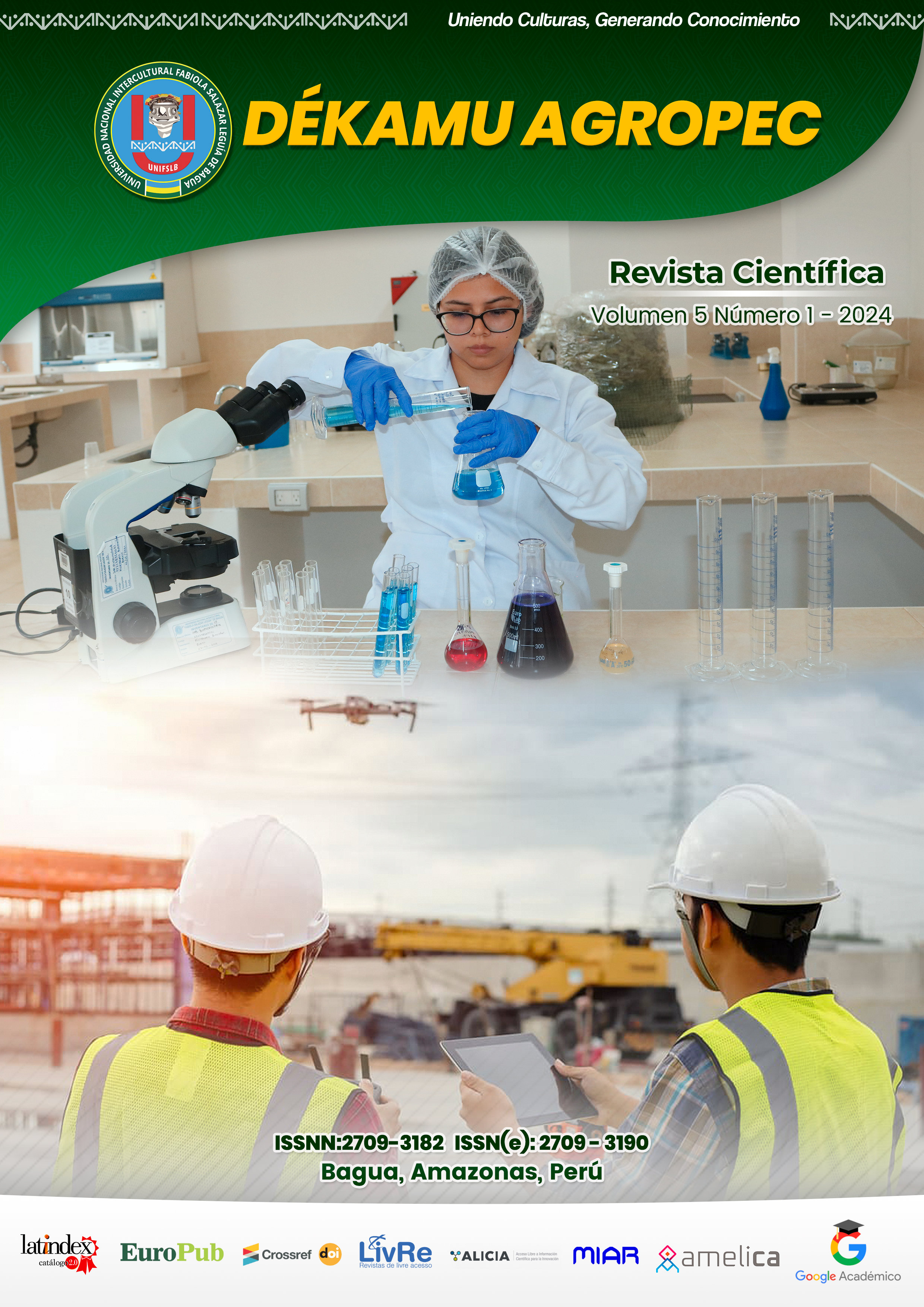Quality and shelf life of blueberry (Vaccinium myrtillus) with edible mucilage coating of coffee (Coffea arabica)
DOI:
https://doi.org/10.55996/dekamuagropec.v5i1.203Keywords:
Blueberry; mucilage coffee; storage temperature; edible coatingAbstract
Blueberries are highly valued globally for their high antioxidant content and resilience to diverse agroclimatic conditions. This study examines the effects of coating blueberries (Vaccinium myrtillus) with an edible coating (CR) made from coffee mucilage on their shelf life and quality. The coating was applied at three different concentrations of coffee mucilage (3%, 5%, and 7%) and subjected to three storage temperatures (20±2 ºC, 4 ºC, and -1 ºC). The research findings indicate that the utilization of a coating formulation containing 5% coffee mucilage, 2.5% starch, and 20% glycerol effectively reduces weight loss in berries at three storage temperatures (20±2, 4, -1 ºC), diminishes titratable acidity, and preserves sugars in comparison to uncoated berries. This creates the possibility of using the coffee-mucilage-based coating as a viable replacement to prolong the shelf life of blueberry and Andean berry crops.
Downloads
References
Habanova, M., Saraiva, J. A., Haban, M., Schwarzova, M., Chlebo, P., Predna, L., ... & Wyka, J. (2016). Intake of bilberries (Vaccinium myrtillus L.) reduced risk factors for cardiovascular disease by inducing favorable changes in lipoprotein profiles. Nutrition Research, 36(12), 1415-1422.
Bilawal, A., Ishfaq, M., Gantumur, M. A., Qayum, A., Shi, R., Fazilani, S. A., ... & Hou, J. (2021). A review of the bioactive ingredients of berries and their applications in curing diseases. Food Bioscience, 44, 101407.
Al-Tayyar, N. A., Youssef, A. M., & Al-Hindi, R. R. (2020). Edible coatings and antimicrobial nanoemulsions for enhancing shelf life and reducing foodborne pathogens of fruits and vegetables: A review. Sustainable Materials and Technologies, 26, e00215.
Álvarez-Herrera, J., Fischer, G., & Vélez, J. E. (2021). Análisis de la producción de uchuva (Physalis peruviana L.) durante el ciclo de cosechas en invernadero con diferentes láminas de riego. Revista de la Academia Colombiana de Ciencias Exactas, Físicas y Naturales, 45(174), 109-121.
Arteaga, A., & Arteaga, H. (2016). Optimización de la capacidad antioxidante, contenido de antocianinas y capacidad de rehidratación en polvo de arándano (Vaccinium corymbosum) microencapsulado con mezclas de hidrocoloides. Scientia Agropecuaria, 7(SPE), 191-200.
Association of Official Agricultural Chemists, & Horwitz, W. (1975). Official methods of analysis (Vol. 222). Washington, DC: Association of Official Analytical Chemists.
Ates, U., Islam, A., Ozturk, B., Aglar, E., Karakaya, O., & Gun, S. (2022). Changes in quality traits and phytochemical components of Blueberry (Vaccinium Corymbosum cv. bluecrop) fruit in response to postharvest aloe vera treatment. International Journal of Fruit Science, 22(1), 303-316.
Ayala, L., Valenzuela, C., & Bohorguez, Y. (2022). Efecto de un recubrimiento comestible a base de alginato de sodio y iones de calcio sobre la calidad de mora de castilla (Rubus glaucus Benth). Vitae, 19(1), S129-S131.
Dhall, R. K. (2013). Advances in edible coatings for fresh fruits and vegetables: a review. Critical reviews in food science and nutrition, 53(5), 435-450.
Dadi, D., Mengistie, E., Terefe, G., Getahun, T., Haddis, A., Birke, W., ... & Van der Bruggen, B. (2018). Assessment of the effluent quality of wet coffee processing wastewater and its influence on downstream water quality. Ecohydrology & Hydrobiology, 18(2), 201-211.
Faria, A., Oliveira, J., Neves, P., Gameiro, P., Santos-Buelga, C., de Freitas, V., & Mateus, N. (2005). Antioxidant properties of prepared blueberry (Vaccinium myrtillus) extracts. Journal of Agricultural and Food chemistry, 53(17), 6896-6902.
Feng, T., Zhang, M., Sun, Q., Mujumdar, A. S., & Yu, D. (2022). Extraction of functional extracts from berries and their high quality processing: A comprehensive review. Critical Reviews in Food Science and Nutrition, 1-18.
Fernández, N., Echeverria, D. C., Mosquera, S. A., & Paz, S. P. (2017). Estado actual del uso de recubrimientos comestibles en frutas y hortalizas. Biotecnología en el sector agropecuario y agroindustrial, 15(2), 134-141.
Forney, C. F., Jordan, M. A., Pennell, K. M., & Fillmore, S. (2022). Controlled atmosphere storage impacts fruit quality and flavor chemistry of five cultivars of highbush blueberry (Vaccinium corymbosum). Postharvest Biology and Technology, 194, 112073.
González, L. R. G. (2011). Desarrollo y evaluación de una película comestible obtenida del mucílago de nopal (Opuntia ficus-indica) utilizada para reducir la tasa de respiración de nopal verdura. Investigación Universitaria Multidisciplinaria: Revista de Investigación de la Universidad Simón Bolívar, (10), 14.
Li, L., Huang, W., Wang, Z., Liu, S., He, X., & Fan, S. (2022). Calibration transfer between developed portable Vis/NIR devices for detection of soluble solids contents in apple. Postharvest Biology and Technology, 183, 111720.
Liu, Y., Chen, N., Ma, Z., Che, F., Mao, J., & Chen, B. (2016). The changes in color, soluble sugars, organic acids, anthocyanins and aroma components in “Starkrimson” during the ripening period in China. Molecules, 21(6), 812.
MINAGRI. (2016). El arandano en el perú y el mundo. Lima. Recuperado el 12 de 07 de 2019, de http://agroaldia.minagri.gob.pe/biblioteca/download/pdf/tematicas/f-taxonomia_plantas/f01-cultivo/el_arandano.pdf
Parodi, G., & Benavides, L. (2021). Desarrollo del cultivo de berries en Perú–Situación y perspectivas. Avances en el cultivo de las berries en el trópico. Sociedad Colombiana de Ciencias Hortícolas, Bogotá.
Pinto, R. R., Medina, J. A., Medina, F. J., Guevara, F., Gómez, H., Ley, A., & Carmona, J. (2014). Sustitución de melaza por mucílago de café (Coffea arabica L.) en bloques nutricionales para rumiantes. Archivos de zootecnia, 63(241), 65-71.
Riva, S. C., Opara, U. O., & Fawole, O. A. (2020). Recent developments on postharvest application of edible coatings on stone fruit: A review. Scientia Horticulturae, 262, 109074. Triunfo, M., Tafi, E., Guarnieri, A., Ianniciello, D., Scieuzo, C., Salvia, R., ... & Falabella, P. (2023). Uso de quitosano de Hermetia illucens como conservante de frutos frescos de la especie Prunus: un análisis preliminar. Tecnologías químicas y biológicas en la agricultura, 10 (1), 101.
Vargas, E. B. A. (2015). Aplicación de revestimientos comestibles en papaya (Carica papaya) mínimamente procesada. INGENIERÍA: Ciencia, Tecnología e Innovación, 2(1), 15-15.
Vieira, J. M., Flores-López, M. L., de Rodríguez, D. J., Sousa, M. C., Vicente, A. A., & Martins, J. T. (2016). Effect of chitosan–Aloe vera coating on postharvest quality of blueberry (Vaccinium corymbosum) fruit. Postharvest Biology and Technology, 116, 88-97.
Villegas, C., & Albarracín, W. (2016). Aplicación y efecto de un recubrimiento comestible sobre la vida útil de la mora de castilla (Rubus glaucus Benth). Vitae, 23(3), 202-209.
Published
How to Cite
Issue
Section
License
Copyright (c) 2024 Mercedes Marín, Ralph Rivera-Botonares, Erick A. Auquiñivin

This work is licensed under a Creative Commons Attribution 4.0 International License.
Los autores que publican en esta revista aceptan los siguientes términos:
- Los autores conservan los derechos de autor y conceden a la revista el derecho publicación con la obra, simultáneamente licenciada bajo una licencia de Creative Commons CC By que permite a otros compartir el trabajo, pero citando la publicación inicial en esta revista.
- Los autores pueden celebrar acuerdos contractuales adicionales separados para la distribución no exclusiva de la versión publicada de la obra de la revista (por ejemplo, publicarla en un repositorio institucional o publicarla en un libro), pero citando la publicación inicial en esta revista.
- Se permite y anima a los autores a publicar su trabajo en línea (por ejemplo, en repositorios institucionales o en su sitio web) antes y durante el proceso de presentación, ya que puede conducir a intercambios productivos, así como una mayor citación del trabajo publicado (https://web-archive.southampton.ac.uk/opcit.eprints.org/oacitation-biblio.html)















